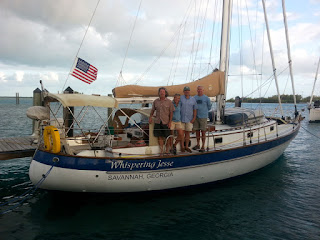We all met in the pink light of dawn at 6:30 the next morning, coffee cups in hand, to see if Brian's plan would work. After a single false start and a minor correction, we were off, with much waving and yelling of thanks. We hope to meet up with those kind sailors again in future travels.
The route out of the channel was considerably easier in daylight, and we adjusted our course to match the one taken by our snorkel trip captain, which put us on the wrong side of one of the markers but also prevented any unwelcome contact with shoals. We motored southwest into deeper water for several hundred yards before rounding into the wind and putting up the mainsail. When we turned back around and put out the jib, Whispering Jesse took off on a fast broad reach. Within moments, we were doing better than 7 knots and heeling just a little too dramatically. We adjusted the traveler to leeward and eased the main, making for a less death-defying ride. We didn't need to make any further adjustments until we entered the Gulfstream, where the dramatic wave action added to the roller-coaster effect and caused us to ease the main a little more. But we were flying! Occasional gusts pushed us above 8 knots, and it felt that we would be back in Miami in no time.
It took only 10 hours to return from Bimini, compared to 18 hours to sail there, and the vastly different tracks tell the story. Speed is the key. Without at least 5 to 6 knots of boat speed, the Gulfstream's 3.5 knots take control and push the boat northward. It may be possible to crab across in a slow easterly direction, but is that any faster than simply using the available wind to get past the Gulfstream and then adjusting southward? Maybe. The best advice is to wait for a southwesterly wind for the passage over to Bimini and a southeasterly wind for the passage back. In other words, trying to sail on a schedule is almost never going to be the safest or most comfortable way to go.

 Raising Charlie: The Lessons of a Perfect Dog
Raising Charlie: The Lessons of a Perfect Dog











